1、背景
- 实现自定义的登录认证。
- 登录成功,生成token并将token 交由redis管理。
- 登录后对用户访问的接口进行接口级别权限认证。
SpringSecurity提供的注解权限校验适合的场景是系统中仅有固定的几个角色,且角色的凭证不可修改(如果修改需要改动代码)。
@PreAuthorize("hasAuthority('ROLE_TELLER')")
public Account post(Account account, double amount);注:ROLE_TELLER是写死的。
后端系统的访问请求有以下几种类型:
- 登录、登出(可自定义url)
- 匿名用户可访问的接口(静态资源,demo示例等)
- 其他接口(在登录的前提下,继续判断访问者是否有权限访问)
2、环境搭建
<!--springSecurity安全框架-->
<dependency>
<groupId>org.springframework.boot</groupId>
<artifactId>spring-boot-starter-security</artifactId>
<version>2.3.4.RELEASE</version>
</dependency>
<!-- 默认通过SESSIONId改为通过请求头与redis配合验证session -->
<dependency>
<groupId>org.springframework.session</groupId>
<artifactId>spring-session-data-redis</artifactId>
<version>2.3.1.RELEASE</version>
</dependency>
<!--redis支持-->
<dependency>
<groupId>org.springframework.boot</groupId>
<artifactId>spring-boot-starter-data-redis</artifactId>
<version>2.3.4.RELEASE</version>
</dependency>注:springBoot版本也是2.3.4.RELEASE,如果有版本对应问题,自行解决。有用到swagger,为了便于测试。
新建springSecurity配置类
WebSecurityConfig作为springSecurity的主配置文件。
@Configuration
@EnableWebSecurity
public class WebSecurityConfig extends WebSecurityConfigurerAdapter {
/**
* Swagger等静态资源不进行拦截
*/
@Override
public void configure(WebSecurity web) {
web.ignoring().antMatchers(
"/*.html",
"/favicon.ico",
"/**/*.html",
"/**/*.css",
"/**/*.js",
"/error",
"/webjars/**",
"/resources/**",
"/swagger-ui.html",
"/swagger-resources/**",
"/v2/api-docs");
}
@Override
protected void configure(HttpSecurity http) throws Exception {
http.authorizeRequests()
//配置一些不需要登录就可以访问的接口
.antMatchers("/demo/**", "/about/**").permitAll()
//任何尚未匹配的URL只需要用户进行身份验证
.anyRequest().authenticated()
.and()
.formLogin()//允许用户进行基于表单的认证
.loginPage("/mylogin");
}
}注:证明可以访问静态资源不会被拦截
自定义登录认证
我们需要自定义:
- 登录过滤器:负责过滤登录请求,再交由自定义的登录认证管理器处理。
- 登录成功处理类:顾名思义,登录成功后的一些处理(设置返回信息提示“登录成功!”,返回数据类型为json)。
- 登录失败处理类:类似登录成功处理类。ps:登录成功处理类和失败处理类有默认的实现可以不自定义。但是建议自定义,因为返回的信息为英文,一般情况不符合要求。
- 登录认证管理器:根据过滤器传过来的登录参数,进行登录认证,认证后授权。
新建登录成功处理类
需要实现 AuthenticationSuccessHandler
@Component
public class CustomAuthenticationSuccessHandler implements AuthenticationSuccessHandler {
private static final Logger LOGGER = LoggerFactory.getLogger(CustomAuthenticationSuccessHandler.class);
@Override
public void onAuthenticationSuccess(HttpServletRequest request, HttpServletResponse response, Authentication authentication) throws IOException {
response.setContentType(MediaType.APPLICATION_JSON_VALUE);
response.setCharacterEncoding(StandardCharsets.UTF_8.toString());
//登录成功返回的认证体,具体格式在后面的登录认证管理器中
String responseJson = JackJsonUtil.object2String(ResponseFactory.success(authentication));
if (LOGGER.isDebugEnabled()) {
LOGGER.debug("登录成功!");
}
response.getWriter().write(responseJson);
}
}新建登录失败处理类
实现 AuthenticationFailureHandler
@Component
public class CustomAuthenticationFailureHandler implements AuthenticationFailureHandler {
private static final Logger LOGGER = LoggerFactory.getLogger(CustomAuthenticationFailureHandler.class);
@Override
public void onAuthenticationFailure(HttpServletRequest request, HttpServletResponse response, AuthenticationException e) throws IOException {
String errorMsg;
if (StringUtils.isNotBlank(e.getMessage())) {
errorMsg = e.getMessage();
} else {
errorMsg = CodeMsgEnum.LOG_IN_FAIL.getMsg();
}
response.setContentType(MediaType.APPLICATION_JSON_VALUE);
response.setCharacterEncoding(StandardCharsets.UTF_8.toString());
String responseJson = JackJsonUtil.object2String(ResponseFactory.fail(CodeMsgEnum.LOG_IN_FAIL,errorMsg));
if (LOGGER.isDebugEnabled()) {
LOGGER.debug("认证失败!");
}
response.getWriter().write(responseJson);
}
}新建登录认证管理器
实现 AuthenticationProvider ,负责具体的身份认证(一般数据库认证,在登录过滤器过滤掉请求后传入)
@Component
public class UserVerifyAuthenticationProvider implements AuthenticationProvider {
private PasswordEncoder passwordEncoder;
@Autowired
private UserService userService;
@Override
public Authentication authenticate(Authentication authentication) throws AuthenticationException {
String userName = (String) authentication.getPrincipal(); // Principal 主体,一般指用户名
String passWord = (String) authentication.getCredentials(); //Credentials 网络凭证,一般指密码
//通过账号去数据库查询用户以及用户拥有的角色信息
UserRoleVo userRoleVo = userService.findUserRoleByAccount(userName);
//数据库密码
String encodedPassword = userRoleVo.getPassWord();
//credentials凭证即为前端传入密码,因为前端一般用Base64加密过所以需要解密。
String credPassword = new String(Base64Utils.decodeFromString(passWord), StandardCharsets.UTF_8);
// 验证密码:前端明文,数据库密文
passwordEncoder = new MD5Util();
if (!passwordEncoder.matches(credPassword, encodedPassword)) {
throw new AuthenticationServiceException("账号或密码错误!");
}
//ps:GrantedAuthority对认证主题的应用层面的授权,含当前用户的权限信息,通常使用角色表示
List<GrantedAuthority> roles = new LinkedList<>();
List<Role> roleList = userRoleVo.getRoleList();
roleList.forEach(role -> {
SimpleGrantedAuthority roleId = new SimpleGrantedAuthority(role.getRoleId().toString());
roles.add(roleId);
});
UsernamePasswordAuthenticationToken token = new UsernamePasswordAuthenticationToken(userName, passWord, roles);
token.setDetails(userRoleVo);//这里可以放用户的详细信息
return token;
}
@Override
public boolean supports(Class<?> authentication) {
return false;
}
}新建登录过滤器
LoginFilter.java继承UsernamePasswordAuthenticationFilter,负责过滤登录请求并交由登录认证管理器进行具体的认证。
public class LoginFilter extends UsernamePasswordAuthenticationFilter {
private UserVerifyAuthenticationProvider authenticationManager;
/**
* @param authenticationManager 认证管理器
* @param successHandler 认证成功处理类
* @param failureHandler 认证失败处理类
*/
public LoginFilter(UserVerifyAuthenticationProvider authenticationManager,
CustomAuthenticationSuccessHandler successHandler,
CustomAuthenticationFailureHandler failureHandler) {
//设置认证管理器(对登录请求进行认证和授权)
this.authenticationManager = authenticationManager;
//设置认证成功后的处理类
this.setAuthenticationSuccessHandler(successHandler);
//设置认证失败后的处理类
this.setAuthenticationFailureHandler(failureHandler);
//可以自定义登录请求的url
super.setFilterProcessesUrl("/myLogin");
}
@Override
public Authentication attemptAuthentication(HttpServletRequest request, HttpServletResponse response) throws AuthenticationException {
try {
//转换请求入参
UserDTO loginUser = new ObjectMapper().readValue(request.getInputStream(), UserDTO.class);
//入参传入认证管理器进行认证
return authenticationManager.authenticate(
new UsernamePasswordAuthenticationToken(loginUser.getUserName(), loginUser.getPassWord())
);
} catch (IOException e) {
e.printStackTrace();
return null;
}
}
}最后配置到WebSecurityConfig中:
@Configuration
@EnableWebSecurity
public class WebSecurityConfig extends WebSecurityConfigurerAdapter {
@Autowired
private UserVerifyAuthenticationProvider authenticationManager;//认证用户类
@Autowired
private CustomAuthenticationSuccessHandler successHandler;//登录认证成功处理类
@Autowired
private CustomAuthenticationFailureHandler failureHandler;//登录认证失败处理类
/**
* Swagger等静态资源不进行拦截
*/
@Override
public void configure(WebSecurity web) {
web.ignoring().antMatchers(
"/*.html",
"/favicon.ico",
"/**/*.html",
"/**/*.css",
"/**/*.js",
"/error",
"/webjars/**",
"/resources/**",
"/swagger-ui.html",
"/swagger-resources/**",
"/v2/api-docs");
}
@Override
protected void configure(HttpSecurity http) throws Exception {
http.authorizeRequests()
//配置一些不需要登录就可以访问的接口
.antMatchers("/demo/**", "/about/**").permitAll()
//任何尚未匹配的URL只需要用户进行身份验证
.anyRequest().authenticated()
.and()
//配置登录过滤器
.addFilter(new LoginFilter(authenticationManager, successHandler, failureHandler))
.csrf().disable();
}
}验证配置
访问登录请求:

成功进入LoginFilter
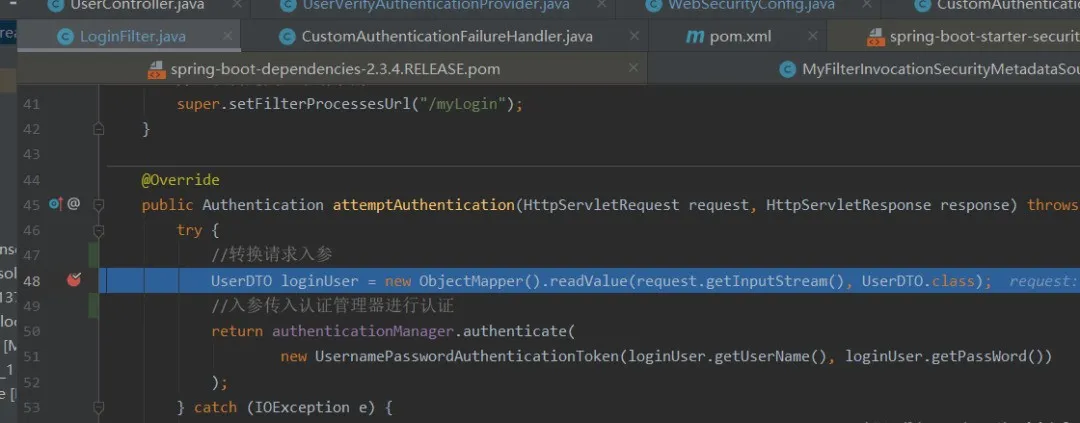 图片
图片
安全头和登录返回token
session:
store-type: redis
redis:
namespace: spring:session:admin
# session 无操作失效时间 30 分钟
timeout: 1800设置token放入返回的header中需要在WebSecurityConfig中加入
/**
* 配置 HttpSessionIdResolver Bean
* 登录之后将会在 Response Header x-auth-token 中 返回当前 sessionToken
* 将token存储在前端 每次调用的时候 Request Header x-auth-token 带上 sessionToken
*/
@Bean
public HttpSessionIdResolver httpSessionIdResolver() {
return HeaderHttpSessionIdResolver.xAuthToken();
}关于安全头信息可以参考:
- https://docs.spring.io/spring-security/site/docs/5.2.1.BUILD-SNAPSHOT/reference/htmlsingle/#ns-headers
安全请求头需要设置WebSecurityConfig中加入
protected void configure(HttpSecurity http) throws Exception {
http.authorizeRequests()
//配置一些不需要登录就可以访问的接口
.antMatchers("/demo/**", "/about/**").permitAll()
//任何尚未匹配的URL只需要用户进行身份验证
.anyRequest().authenticated()
.and()
//配置登录过滤器
.addFilter(new LoginFilter(authenticationManager, successHandler, failureHandler))
.csrf().disable();
//配置头部
http.headers()
.contentTypeOptions()
.and()
.xssProtection()
.and()
//禁用缓存
.cacheControl()
.and()
.httpStrictTransportSecurity()
.and()
//禁用页面镶嵌frame劫持安全协议 // 防止iframe 造成跨域
.frameOptions().disable();
}进行登录测试,验证结果:
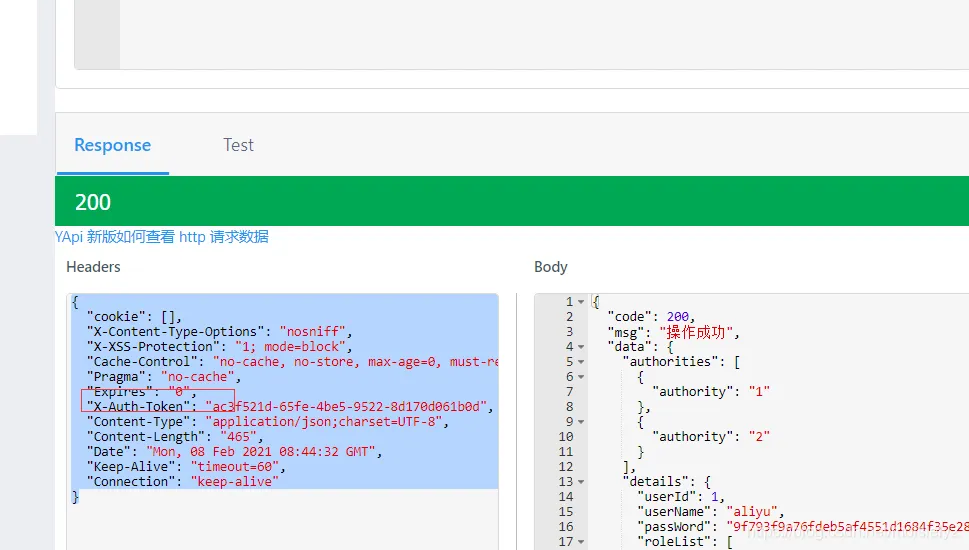 图片
图片
注:响应中有token
查看redis。成功保存进了redis
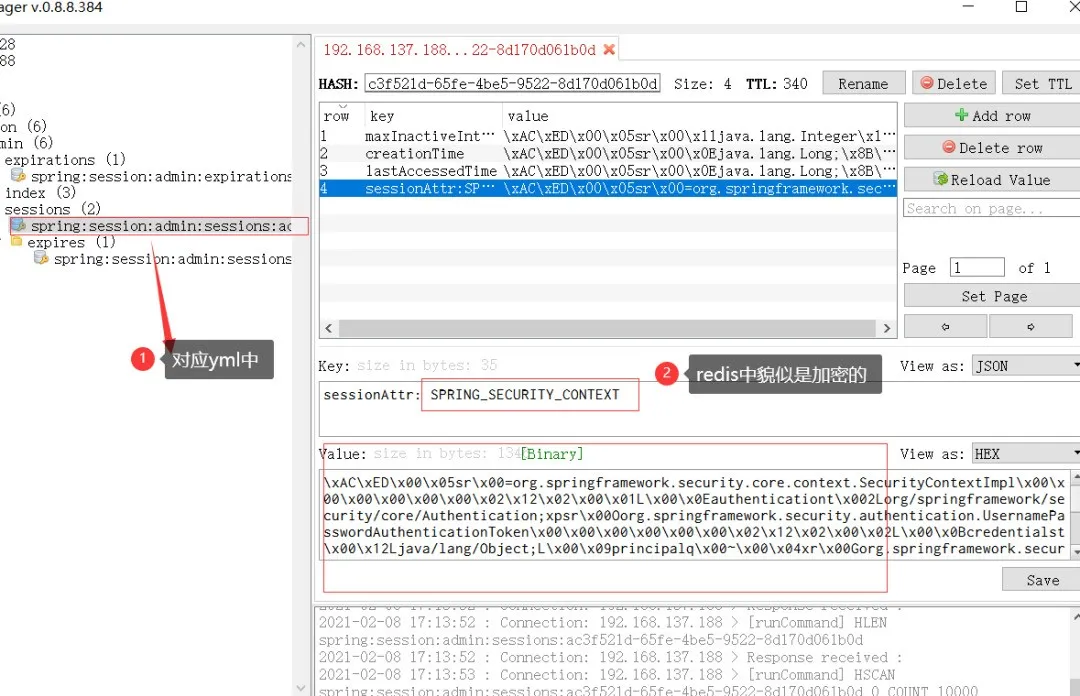 图片
图片
接口权限校验
Spring Security使用FilterSecurityInterceptor过滤器来进行URL权限校验,实际使用流程大致如下:
正常情况的接口权限判断:
返回那些可以访问当前url的角色
1、定义一个MyFilterInvocationSecurityMetadataSource实现FilterInvocationSecurityMetadataSource类,重写getAttributes方法。
方法的作用是:返回哪些角色可以访问当前url,这个肯定是从数据库中获取。要注意的是对于PathVariable传参的url,数据库中存的是这样的:/getUserByName/{name}。但实际访问的url中name是具体的值。类似的/user/getUserById 也可以匹配 /user/getUserById?1。
package com.aliyu.security.provider;
import com.aliyu.service.role.RoleService;
import org.springframework.beans.factory.annotation.Autowired;
import org.springframework.security.access.ConfigAttribute;
import org.springframework.security.access.SecurityConfig;
import org.springframework.security.web.FilterInvocation;
import org.springframework.security.web.access.intercept.FilterInvocationSecurityMetadataSource;
import org.springframework.security.web.util.matcher.AntPathRequestMatcher;
import org.springframework.stereotype.Component;
import javax.servlet.http.HttpServletRequest;
import java.util.Collection;
import java.util.List;
import java.util.Map;
/**
*@create:
*@description: 第一步:数据库查询所有权限出来:
* 之所以要所有权限,因为数据库url和实际请求url并不能直接匹配需要。比方:/user/getUserById 匹配 /user/getUserById?1
* 第二步:通过httpUrl匹配器找出允许访问当前请求的角色列表(哪些角色可以访问此请求)
*/
@Component
public class MyFilterInvocationSecurityMetadataSource implements FilterInvocationSecurityMetadataSource {
@Autowired
private RoleService roleService;
/**
* 返回当前URL允许访问的角色列表
* @param object
* @return
* @throws IllegalArgumentException
*/
@Override
public Collection<ConfigAttribute> getAttributes(Object object) throws IllegalArgumentException {
//入参转为HttpServletRequest
FilterInvocation fi = (FilterInvocation) object;
HttpServletRequest request = fi.getRequest();
//从数据库中查询系统所有的权限,格式为<"权限url","能访问url的逗号分隔的roleid">
List<Map<String, String>> allUrlRoleMap = roleService.getAllUrlRoleMap();
for (Map<String, String> urlRoleMap : allUrlRoleMap) {
String url = urlRoleMap.get("url");
String roles = urlRoleMap.get("roles");
//new AntPathRequestMatcher创建httpUrl匹配器:里面url匹配规则已经给我们弄好了,
// 能够支持校验PathVariable传参的url(例如:/getUserByName/{name})
// 也能支持 /user/getUserById 匹配 /user/getUserById?1
AntPathRequestMatcher matcher = new AntPathRequestMatcher(url);
if (matcher.matches(request)){ //当前请求与httpUrl匹配器进行匹配
return SecurityConfig.createList(roles.split(","));
}
}
return null;
}
@Override
public Collection<ConfigAttribute> getAllConfigAttributes() {
return null;
}
@Override
public boolean supports(Class<?> clazz) {
return FilterInvocation.class.isAssignableFrom(clazz);
}
}注:
1. 方案一是初始化的时候加载所有权限,一次就好了。
2. 方案二每次请求都会去重新加载系统所有权限,好处就是不用担心权限修改的问题。(本次实现方案)
3. 方案三利用Redis缓存
判断当前用户是否拥有访问当前url的角色
定义一个MyAccessDecisionManager:通过实现AccessDecisionManager接口自定义一个决策管理器,判断是否有访问权限。上一步MyFilterInvocationSecurityMetadataSource中返回的当前请求可以访问角色列表会传到这里的decide方法里面(如果没有角色的话,不会进入decide方法。
正常情况你访问的url必然和某个角色关联,如果没有关联就不应该可以访问)。decide方法传了当前登录用户拥有的角色,通过判断用户拥有的角色中是否有一个角色和当前url可以访问的角色匹配。如果匹配,权限校验通过。
package com.aliyu.security.provider;
import org.apache.commons.lang3.StringUtils;
import org.springframework.security.access.AccessDecisionManager;
import org.springframework.security.access.AccessDeniedException;
import org.springframework.security.access.ConfigAttribute;
import org.springframework.security.authentication.AnonymousAuthenticationToken;
import org.springframework.security.authentication.InsufficientAuthenticationException;
import org.springframework.security.core.Authentication;
import org.springframework.security.core.GrantedAuthority;
import org.springframework.security.web.FilterInvocation;
import org.springframework.stereotype.Component;
import java.util.Collection;
import java.util.Iterator;
/**
*@create:
*@description: 接口权限判断(根据MyFilterInvocationSecurityMetadataSource获取到的请求需要的角色
* 和当前登录人的角色进行比较)
*/
@Component
public class MyAccessDecisionManager implements AccessDecisionManager {
@Override
public void decide(Authentication authentication, Object object, Collection<ConfigAttribute> configAttributes) throws AccessDeniedException, InsufficientAuthenticationException {
//循环请求需要的角色,只要当前用户拥有的角色中包含请求需要的角色中的一个,就算通过。
Iterator<ConfigAttribute> iterator = configAttributes.iterator();
while(iterator.hasNext()){
ConfigAttribute configAttribute = iterator.next();
String needCode = configAttribute.getAttribute();
//获取到了登录用户的所有角色
Collection<? extends GrantedAuthority> authorities = authentication.getAuthorities();
for (GrantedAuthority authority : authorities) {
if (StringUtils.equals(authority.getAuthority(), needCode)) {
return;
}
}
}
throw new AccessDeniedException("当前访问没有权限");
}
@Override
public boolean supports(ConfigAttribute attribute) {
return false;
}
@Override
public boolean supports(Class<?> clazz) {
return FilterInvocation.class.isAssignableFrom(clazz);
}
}处理匿名用户访问无权限资源
1、定义一个CustomAuthenticationEntryPoint实现AuthenticationEntryPoint处理匿名用户访问无权限资源(可以理解为未登录的用户访问,确实有些接口是可以不登录也能访问的,比较少,我们在WebSecurityConfig已经配置过了。如果多的话,需要另外考虑从数据库中获取,并且权限需要加一个标志它为匿名用户可访问)。
package com.aliyu.security.handler;
import com.aliyu.common.util.JackJsonUtil;
import com.aliyu.entity.common.vo.ResponseFactory;
import com.aliyu.security.constant.MessageConstant;
import org.slf4j.Logger;
import org.slf4j.LoggerFactory;
import org.springframework.http.MediaType;
import org.springframework.security.core.AuthenticationException;
import org.springframework.security.web.AuthenticationEntryPoint;
import javax.servlet.http.HttpServletRequest;
import javax.servlet.http.HttpServletResponse;
import java.io.IOException;
import java.nio.charset.StandardCharsets;
import static com.aliyu.entity.common.exception.CodeMsgEnum.MOVED_PERMANENTLY;
/**
* 未登录重定向处理器
* <p>
* 未登录状态下访问需要登录的接口
*
* @author
*/
public class CustomAuthenticationEntryPoint implements AuthenticationEntryPoint {
private static final Logger LOGGER = LoggerFactory.getLogger(CustomAuthenticationEntryPoint.class);
@Override
public void commence(HttpServletRequest request, HttpServletResponse response, AuthenticationException e) throws IOException {
response.setContentType(MediaType.APPLICATION_JSON_VALUE);
response.setCharacterEncoding(StandardCharsets.UTF_8.toString());
//原来不需要登录的接口,现在需要登录了,所以叫永久移动
String message = JackJsonUtil.object2String(
ResponseFactory.fail(MOVED_PERMANENTLY, MessageConstant.NOT_LOGGED_IN)
);
if (LOGGER.isDebugEnabled()) {
LOGGER.debug("未登录重定向!");
}
response.getWriter().write(message);
}
}处理登陆认证过的用户访问无权限资源
2、定义一个CustomAccessDeniedHandler 实现AccessDeniedHandler处理登陆认证过的用户访问无权限资源。
package com.aliyu.security.handler;
import com.aliyu.common.util.JackJsonUtil;
import com.aliyu.entity.common.exception.CodeMsgEnum;
import com.aliyu.entity.common.vo.ResponseFactory;
import com.aliyu.security.constant.MessageConstant;
import org.slf4j.Logger;
import org.slf4j.LoggerFactory;
import org.springframework.http.MediaType;
import org.springframework.security.access.AccessDeniedException;
import org.springframework.security.web.access.AccessDeniedHandler;
import javax.servlet.http.HttpServletRequest;
import javax.servlet.http.HttpServletResponse;
import java.io.IOException;
import java.nio.charset.StandardCharsets;
/**
* 拒绝访问处理器(登录状态下,访问没有权限的方法时会进入此处理器)
*
* @author
*/
public class CustomAccessDeniedHandler implements AccessDeniedHandler {
private static final Logger LOGGER = LoggerFactory.getLogger(CustomAccessDeniedHandler.class);
@Override
public void handle(HttpServletRequest request, HttpServletResponse response, AccessDeniedException e) throws IOException {
response.setContentType(MediaType.APPLICATION_JSON_VALUE);
response.setCharacterEncoding(StandardCharsets.UTF_8.toString());
String message = JackJsonUtil.object2String(
ResponseFactory.fail(CodeMsgEnum.UNAUTHORIZED, MessageConstant.NO_ACCESS)
);
if(LOGGER.isDebugEnabled()){
LOGGER.debug("没有权限访问!");
}
response.getWriter().write(message);
}
}配置到WebSecurityConfig
package com.aliyu.security.config;
import com.aliyu.filter.LoginFilter;
import com.aliyu.security.handler.*;
import com.aliyu.security.provider.MyAccessDecisionManager;
import com.aliyu.security.provider.MyFilterInvocationSecurityMetadataSource;
import com.aliyu.security.provider.UserVerifyAuthenticationProvider;
import org.springframework.beans.factory.annotation.Autowired;
import org.springframework.boot.autoconfigure.condition.ConditionalOnMissingBean;
import org.springframework.context.annotation.Bean;
import org.springframework.context.annotation.Configuration;
import org.springframework.security.config.annotation.ObjectPostProcessor;
import org.springframework.security.config.annotation.web.builders.HttpSecurity;
import org.springframework.security.config.annotation.web.builders.WebSecurity;
import org.springframework.security.config.annotation.web.configuration.EnableWebSecurity;
import org.springframework.security.config.annotation.web.configuration.WebSecurityConfigurerAdapter;
import org.springframework.security.crypto.bcrypt.BCryptPasswordEncoder;
import org.springframework.security.crypto.password.PasswordEncoder;
import org.springframework.security.web.access.intercept.FilterSecurityInterceptor;
import org.springframework.session.web.http.HeaderHttpSessionIdResolver;
import org.springframework.session.web.http.HttpSessionIdResolver;
@Configuration
@EnableWebSecurity
public class WebSecurityConfig extends WebSecurityConfigurerAdapter {
@Autowired
private UserVerifyAuthenticationProvider authenticationManager;//认证用户类
@Autowired
private CustomAuthenticationSuccessHandler successHandler;//登录认证成功处理类
@Autowired
private CustomAuthenticationFailureHandler failureHandler;//登录认证失败处理类
@Autowired
private MyFilterInvocationSecurityMetadataSource securityMetadataSource;//返回当前URL允许访问的角色列表
@Autowired
private MyAccessDecisionManager accessDecisionManager;//除登录登出外所有接口的权限校验
/**
* 密码加密
* @return
*/
@Bean
@ConditionalOnMissingBean(PasswordEncoder.class)
public PasswordEncoder passwordEncoder() {
return new BCryptPasswordEncoder();
}
/**
* 配置 HttpSessionIdResolver Bean
* 登录之后将会在 Response Header x-auth-token 中 返回当前 sessionToken
* 将token存储在前端 每次调用的时候 Request Header x-auth-token 带上 sessionToken
*/
@Bean
public HttpSessionIdResolver httpSessionIdResolver() {
return HeaderHttpSessionIdResolver.xAuthToken();
}
/**
* Swagger等静态资源不进行拦截
*/
@Override
public void configure(WebSecurity web) {
web.ignoring().antMatchers(
"/*.html",
"/favicon.ico",
"/**/*.html",
"/**/*.css",
"/**/*.js",
"/error",
"/webjars/**",
"/resources/**",
"/swagger-ui.html",
"/swagger-resources/**",
"/v2/api-docs");
}
@Override
protected void configure(HttpSecurity http) throws Exception {
http.authorizeRequests()
//配置一些不需要登录就可以访问的接口
.antMatchers("/demo/**", "/about/**").permitAll()
//任何尚未匹配的URL只需要用户进行身份验证
.anyRequest().authenticated()
//登录后的接口权限校验
.withObjectPostProcessor(new ObjectPostProcessor<FilterSecurityInterceptor>() {
@Override
public <O extends FilterSecurityInterceptor> O postProcess(O object) {
object.setAccessDecisionManager(accessDecisionManager);
object.setSecurityMetadataSource(securityMetadataSource);
return object;
}
})
.and()
//配置登出处理
.logout().logoutUrl("/logout")
.logoutSuccessHandler(new CustomLogoutSuccessHandler())
.clearAuthentication(true)
.and()
//用来解决匿名用户访问无权限资源时的异常
.exceptionHandling().authenticationEntryPoint(new CustomAuthenticationEntryPoint())
//用来解决登陆认证过的用户访问无权限资源时的异常
.accessDeniedHandler(new CustomAccessDeniedHandler())
.and()
//配置登录过滤器
.addFilter(new LoginFilter(authenticationManager, successHandler, failureHandler))
.csrf().disable();
//配置头部
http.headers()
.contentTypeOptions()
.and()
.xssProtection()
.and()
//禁用缓存
.cacheControl()
.and()
.httpStrictTransportSecurity()
.and()
//禁用页面镶嵌frame劫持安全协议 // 防止iframe 造成跨域
.frameOptions().disable();
}
}3、其他
特别的,我们认为如果一个接口属于当前系统,那么它就应该有对应可以访问的角色。这样的接口才会被我们限制住。如果一个接口只是在当前系统定义了,而没有指明它的角色,这样的接口是不会被我们限制的。
注意点
下面的代码,本意是想配置一些不需要登录也可以访问的接口。
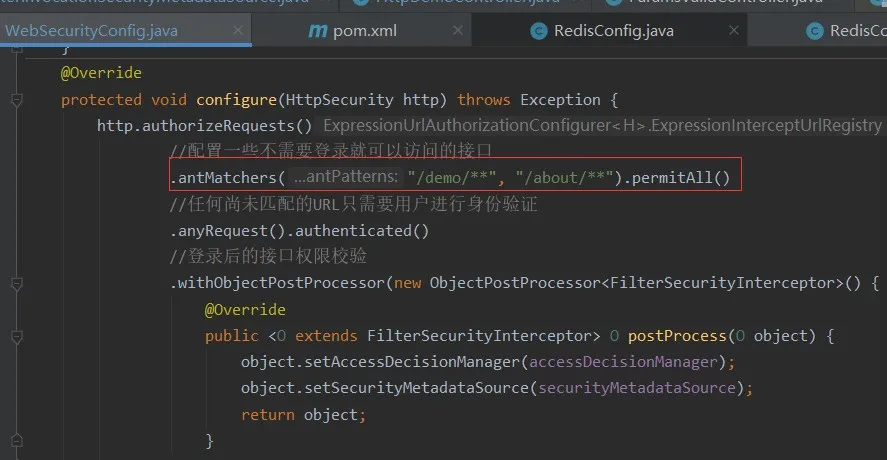 图片
图片
但是测试的时候发现,任何接口的调用都会进入这里MyFilterInvocationSecurityMetadataSource getAttriButes方法,包括我webSecurityConfig里配置的不需要登录的url。结果就是不需要登录的url和没有配置角色的接口权限一样待遇,要么都能访问,要么都不能访问!!!
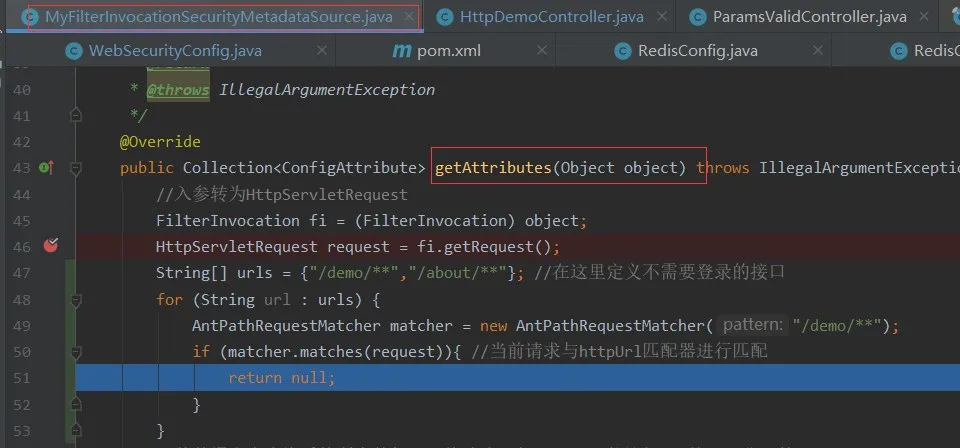
所以如上图,我在这里配置了不需要登录的接口(因为不知道如何从webSercurityConfig中获取,干脆就配置在这里了),去掉了webSercurityConfig中的相应配置。































